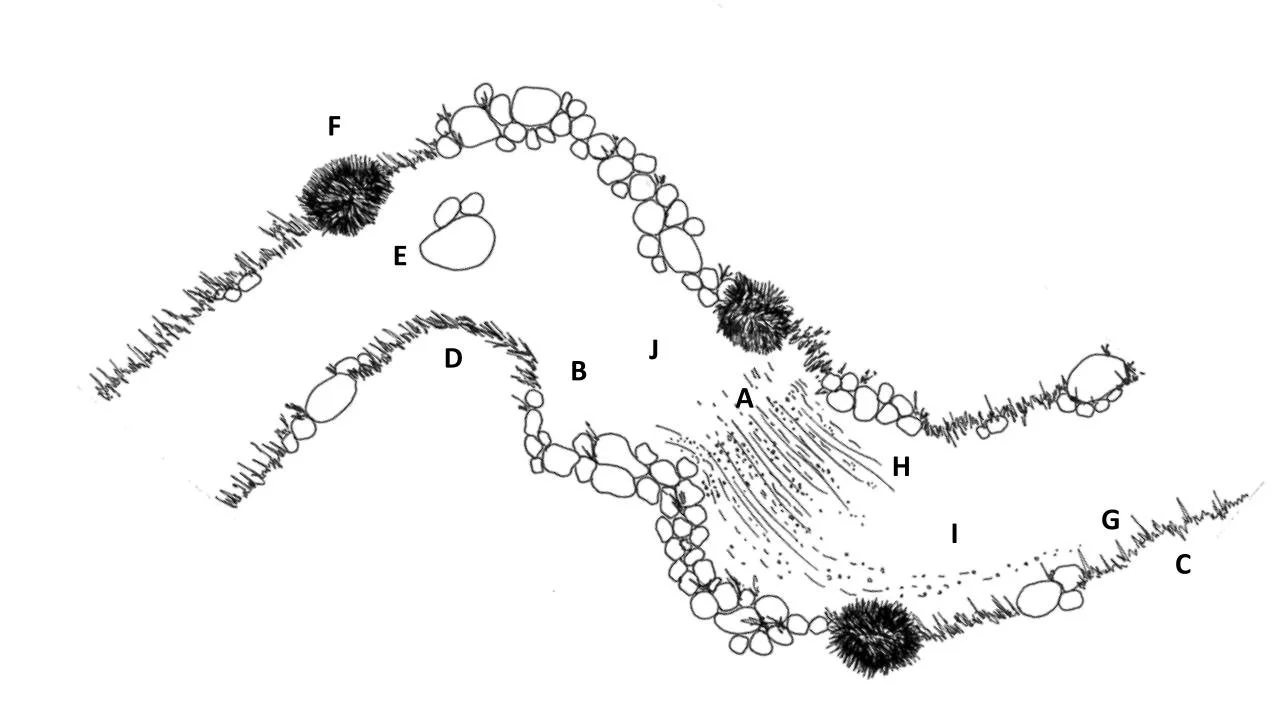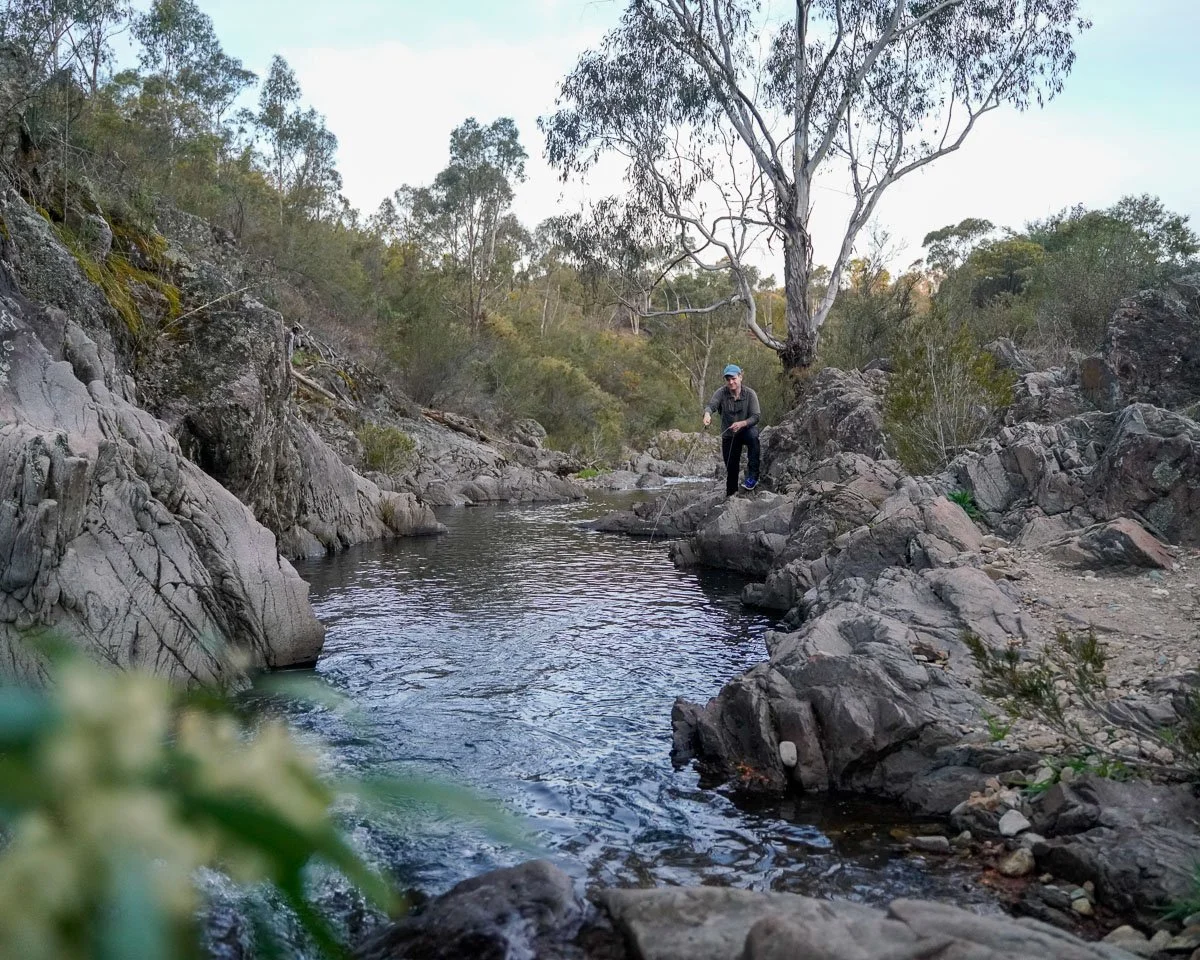How to find trout
Trying to break down where to start fishing when first arriving at a river big or small, can be daunting. In the absence of rising fish, or gin clear water enabling polaroiding your quarry it can seem pretty tough to know where to start. Ostensibly, the river can appear to be a single domineering mass moving silently onward, determined not to give up her secrets easily. The positioning of the trout within the river could be ubiquitous, it could be nought. However, with some basic understanding of trout behavior and hydrology the daunting prospect of a single mass of water can be quickly transformed into easily manageable segments of likely trout lies. A simplified formula of cover + reduced flow + ease for holding points.
On our trip to determine the best dry fly, Favoured Feathers, there were plenty of variables being bandied around in the form of an internalised interrogation. Is my chosen dry fly really the right one for this high country stream? Are the trout feeding? Is it the right time of day or even the right time of year to be out here?. A question that didn’t feature was ‘am I even putting my flies in front of the trout?’ It’s well known when you choose a fly you have confidence in, you fish it with confidence, and throughout Favoured Feather, this intangible factor seemed to unexplainably deliver. What is often, and criminally disregarded, is that when you fish in the right places, the right spots, you also fish with confidence. There are so many variables to fly fishing, but not fishing all the water, only the most likely of spots certainly helped us on our way that day.
A: Riffles
Riffles are a softer form of broken water, often stretching bank to bank, flowing atop smaller freestone and gravel river beds. Look for repeated small waves through a shallow depth. This shallower depth allows significant sunlight to fuel photosynthesis for algae to grow and form as food for nymphs. Coupled with the many nooks and crannies amongst the rocks acting as haven for sub aquatic insect life to begin their lifecycle, riffles serve as a pretty good production house for trout food.
Despite the shallower depth often limiting the holding water for trout, riffles are always worth a good polaroid and prospecting cast or two. Noting their proficiency in housing food, likely holding points immediately downstream of riffles are usually productive fishing spots.
B: Backwaters/eddies
Backwater or eddies, are sections of water where the current is physically manipulated by some form of structure to flow back upstream, opposed to the flow of the main current. They are situated on the banks of the river, off to the side of the main flow. They can often appear as swirling water. The more turbulent ones are nicknamed by some as ‘washing machines’.
Notable features include the reduced velocity of flow, requiring less assertion of effort for the trout to ‘hold’ in an eddy. As the flow of the eddy is generally pulling water away from the main current, resulting food is channeled here as well. The combined prospect of easy holding water with plenty of food is too good an opportunity for the ever opportunistic trout.
Don't forget that due to the generally inverted direction of flow vs. the main current, fish will be facing ‘downstream’ while holding in the back eddies. Approach these stretches of water with stealth, and consider doing so from an upstream position.
Backwater brown
C: Undercut banks
Banks provide safe haven for trout from river predators both overhead and from within. Keeping this refuge within easy access is a trout’s priority, and the ability to meld their back way into the depths and crevasses a bank provides is welcome. Banks also have the effect of slowing the flow, enabling easier holding positions all while maintaining easy access to the main current and the subsequent food conveyor belt it acts as.
D: Corners
Corners are frequent on any stream throughout Australia and New Zealand. They will have the faster deeper water on the ‘outside’, or at the convex of the bend, and the softer, shallower water on the inside. Again, slower flow with easy access to the main current and food are big ticket items for the trout.
E: Rocks/Boulders
Rocks and boulders naturally break up the flow and current of the main river. By slowing the flow, the sections immediately downstream of the structure will be appealing to the trout. However, perhaps more interestingly, due to the hydrology of the flow, the spot immediately upstream of the boulder also offers a lie with low flow and access to current. Trout are more likely to be found here, immediately upstream of the rocks and boulders.
It is important to remember that while most rocks and boulders protrude from the river, some can be fully submerged and hard to spot. These two serve the same function of disrupting flow and creating ‘pockets’ for trout to race out and snag food from the main current.
F: Cover
Any form of structure that extends over the river, prohibiting a line of sight from above is welcome news for trout. Trout are aware that predators in the sky can quickly make light work of any visible trout. It can be lights out before they even realise and they generally don't roll the dice in exposed spots in high sun throughout the day.
Combine cover with any of the other mentioned structural elements and you have won the trout holding spot luxury.
G: Bubble lines or Foam lines
‘Foam is home’ is a hall of fame entrant for fly fishing adages, and with good reason. The foam, or the bubbles, provide an indication to the concentration of current and flow within a river. This concentration of current naturally results in a concentration of food. The trout are well aware of this. Generally bubble lines form in slower pools with lesser current, resulting in our favourite formula of easy holding water with an accessible and frequent food source. Never neglect a bubble line, always rip a cast or five through each. You will rarely regret it.
H: Seams
Seams are the ‘friction’ points between two different speeds of current or flow. They are often found at the meeting point of the main current, and pocket water, eddies and slack sections. They are fantastic indications for the anglers eye as to where trout can hold in slower water, but easily access faster current. In terms of likelihood, they are not dissimilar to bubble lines and should never be passed up.
I: Head or Eye of the pool
The head, or eye, of the pool is the upstream point of a pool, where the water funnels in. Generally, they are deep sections, worn down from a millennia of current and flow plunging in. They are the point in which the flow slows down. They serve as the perfect cocktail of refuge from the depth, easy holding point from the slower flow, and a readily available, and constantly replenishing food source from the inflow of water. It is not uncommon to see the king of the pool, the dominant specimen, holding court here.
J: Tail outs
Tail outs are the points of a pool, or run where the water flows out, onto the next one. Generally, they are shallower sections, with flow building in pace as it prepares to tumble down the next set of rapids or riffles. It is often that you find stratified flow here, that being different currents at different depths throughout the water column. Trout, naturally, will sit on the bottom in the slower flow rate, while the water closer to the surface flows faster above. It makes for some tricky fishing, due to drag and difficulty in securing a natural drift. Yet it is a comparatively easy section to polaroid fish and can make for some great sight fishing.









